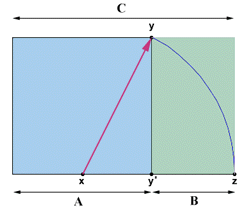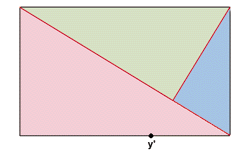|
Technique -
Technique
|
THE GOLDEN MEAN
Let's start with an introduction of a technique
that is well known for many centuries now: The "Golden Mean" (sometimes
called "Golden Section") is a geometric formula by the ancient Greeks.
A composition following this rule is thought to be "harmonious". The principal
idea behind it is to provide geometric lines which can be traversed when
viewing a composition. The Golden Mean was a major guideline for many artists/painters
so it is certainly worth to have in mind for modern day photographers as
well.
Theory - Part I
Well, let's begin with some words about the
theory. The formula starts with a perfect square (marked blue in illustration
A). Now we divide the base of the square into two equal parts. We take
point x as the middle of a circle with a radius of the distance between
point x and y. Thereafter we expand the base of the square till it hits
the circle at point z. Now the square can be transformed to a rectangle
with a proportion ratio of 5:8. The ratio of A to C is the same as the
one from A to B. Luckily the 5:8 ration fits pretty close to the ratio
of the 35mm format (24x36mm = 5:7.5).

Illustration A
|
Theory - Part II
So now we've something which is thought to
be a "perfect" rectangle. What's next ? We draw a line from the upper left
to the lower right edge of the rectangle (see illustration B) and another
line from the upper right directed towards point y' (taken from illustration
A) till it hits the first cross line. Obviously this divides the rectangle
into three different sections.
In principal we're finished with the "Golden
Mean" now. Just try to find objects/parts in your scene that fit roughly
into these three sections and ... you have a "harmonious" composition.
You can vary the formula by flipping and/or mirroring the schematic rectangle from illustration B.

Illustration B |
|
|